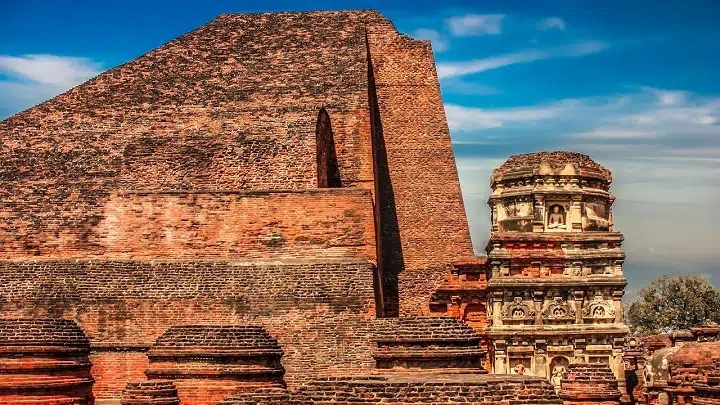Nalanda stands not just as a physical ruin but as a powerful symbol of one of the most glorious eras in India’s intellectual and cultural history. It represents the unmatched heights of knowledge, spirituality, and global academic excellence that India had achieved centuries ago. More than just an ancient university, Nalanda is a reminder of how far the pursuit of education and enlightenment can go when nurtured by a society.
The Origin of Nalanda

Founded in the 5th century CE during the Gupta dynasty, Nalanda was a monastic university located in present-day Bihar, India. It rose to prominence as a major center of learning for over 700 years, attracting scholars from all across Asia—China, Korea, Tibet, and Southeast Asia.
Its name, derived from Sanskrit, is believed to mean “giver of knowledge” or “without interruption,” symbolizing the flow of learning and wisdom that took place on its grounds.
A Center of Global Learning
What set Nalanda apart was its vast curriculum, open academic environment, and rigorous intellectual debates. Subjects taught included:
- Logic and grammar
- Medicine and mathematics
- Astronomy and metaphysics
- Buddhism, Jainism, and other philosophies
The university housed thousands of students and teachers at any given time. It had one of the world’s earliest known residential campuses, with dormitories, temples, meditation halls, and extensive libraries spread across several hectares.
International Attraction and Influence
Nalanda wasn’t just a local center; it was international in its appeal and influence. Some of the most notable foreign scholars to study or teach there included:
- Xuanzang (7th century): The Chinese monk and traveler who studied and carried back over 600 texts to China
- Yijing: Another Chinese pilgrim who left detailed records of the daily life at Nalanda
These travelers wrote about the discipline, scholarship, and architecture of Nalanda, and helped spread Indian philosophy and science across Asia.
The Libraries of Nalanda
Nalanda’s libraries were legendary. Referred to as Dharmaganja, the library complex was divided into three main buildings:
- Ratnasagara (Ocean of Jewels)
- Ratnodadhi (Sea of Jewels)
- Ratnaranjaka (Delighter of Jewels)
These structures were said to have housed hundreds of thousands of manuscripts, palm-leaf texts, and scrolls. When the university was attacked and destroyed in the 12th century, it’s said that the library burned for months due to the volume of flammable material.
The Fall of a Glorious Symbol
Nalanda met its tragic end around 1193 CE when it was destroyed by Bakhtiyar Khilji’s army. The loss wasn’t just physical—it symbolized the fall of a magnificent intellectual ecosystem that took centuries to build. India lost a treasure of wisdom, research, and cultural exchange that had shaped generations.
Despite its destruction, the memory and impact of Nalanda continued to live on in Buddhist traditions across Asia. Monasteries in countries like Tibet and China continued Nalanda’s legacy, preserving texts and philosophies derived from its scholars.
Modern Revival and Recognition
In 2010, the Nalanda University project was initiated by the Government of India in collaboration with East Asian countries to revive the legacy of the ancient seat of learning. The new university aims to:
- Promote inter-Asian academic exchange
- Encourage research in historical studies, environmental science, and philosophy
- Re-establish India’s ancient tradition of global scholarship
The new campus near the original site serves as a living tribute to the original institution and continues to attract students from multiple countries.
Why Nalanda Remains a Symbol of the Most Glorious
There are several reasons Nalanda is viewed as a symbol of India’s glorious past:
- Inclusivity: It welcomed scholars from diverse cultures and backgrounds.
- Knowledge Integration: It combined philosophy, science, logic, and arts under one academic roof.
- Global Impact: Its scholars influenced thinking far beyond India’s borders.
- Spiritual Foundation: Learning was deeply connected to self-discipline and ethical living.
Even in its ruins, Nalanda inspires awe. Its remains were declared a UNESCO World Heritage Site, acknowledging its historical and cultural significance on a global scale.
FAQs About Nalanda as a Glorious Symbol
Why is Nalanda considered a symbol of ancient glory?
Because it was one of the world’s earliest and most advanced universities, known for its academic excellence and international reach.
Who were the key figures associated with Nalanda?
Xuanzang and Yijing are the most famous international scholars linked to Nalanda. Indian philosopher Nagarjuna is also believed to have studied there.
What happened to the original Nalanda University?
It was destroyed in the 12th century during a military raid, leading to the loss of countless texts and centuries of knowledge.
Is there a modern version of Nalanda today?
Yes, a modern Nalanda University was established in 2010 to revive the values and international collaboration once promoted by the ancient site.
What subjects were taught at Nalanda?
A wide range of topics including medicine, astronomy, grammar, logic, and multiple schools of philosophy.
Nalanda continues to shine as a symbol of the most glorious chapter in India’s intellectual and spiritual history. It represented an era where education was sacred, knowledge was shared across cultures, and learning was a way of life. As we strive to build a modern world informed by cooperation and wisdom, the legacy of Nalanda serves as a guiding light. It reminds us that the pursuit of knowledge, when grounded in values, can transcend time, geography, and conflict.

